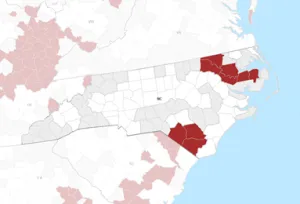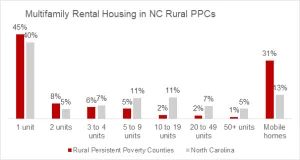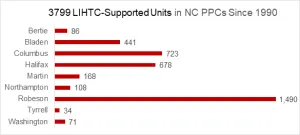
Developing new affordable housing in rural counties with persistent poverty is a challenge. Although renters in these regions often experience more housing stress than in other parts of the country, low incomes and low population density can make multifamily housing economically infeasible without public investment. A new white paper from Freddie Mac shows that the Low-Income Housing Tax Credit (LIHTC) supports 40% of the multifamily housing market in rural Persistent Poverty Counties (PPCs), a rate more than three times greater than the national average and one and a half times greater than all rural areas.
PPCs are counties that have had a poverty rate of at least 20% in each of the last three decennial censuses (1990 to 2010). The Government Accountability Office (GAO) identified 409 persistent poverty counties, of which roughly half were rural. Approximately 7.9 million people, 2.5% of total U.S. population, live in rural PPCs. North Carolina has nine rural PPCs, which are home to 345,000 people, about 3% of the state population.
Figure 1: Persistent Poverty Counties in North Carolina

Source: USDA Economic Research using data from US Census Bureau. PPCs include Bertie, Bladen, Columbus, Halifax, Martin, Northampton, Robeson, Tyrell and Washington
PPCs generally have less multifamily housing, than other counties. Nationwide, approximately 65% of all rentals in PPCs are in properties with fewer than five units. In North Carolina, 59% of rentals in PPCs are in properties with fewer than five units, compared to the statewide rate of 52%.
Figure 2

Source: NCHFA tabulations of 2019 5yr ACS
LIHTC plays a significant role in financing the multifamily stock that does exist in PPCs. Of the 151,538 multifamily units in rural PPCs nationwide, LITHC supports 60,833 (40%). The percentage is even higher in North Carolina where out of the 4,353 multifamily units in rural PPCs, 87% are actively supported by LIHTC. Since 1990, 100 properties have been built across the nine PPCs, adding 3,799 affordable units to the rental market.
Figure 3

Source: NCHFA analysis of LIHTC awards
LIHTC-supported housing makes up a large percentage of the multifamily rental market because in many cases, it is the only way to provide it. Rents in multifamily units must remain relatively low to remain accessible to renters in PPCs, which often have fewer job opportunities and low incomes for the jobs that do exist. LIHTC, along with other sources of public and private funding, make development feasible in PPCs while keeping rents affordable.
The North Carolina Housing Finance Agency operates the LIHTC program in the state. Additional long-term financing for tax credit developments comes from the state’s Workforce Housing Loan Program (WHLP) and the Agency’s Rental Production Program (RPP), funded by the federal Home Investment Partnerships Program, the National Housing Trust Fund and the State Housing Trust Funds. Of the 100 LIHTC properties in rural PPCs, 22 have received RPP funds, 6 have received WHLP funds and 5 have receive both WHLP and RPP funds. Since 1990, rural PPCs have received nearly $25 million in WHLP and RPP funds, leveraging LITHC investments to promote housing stability.